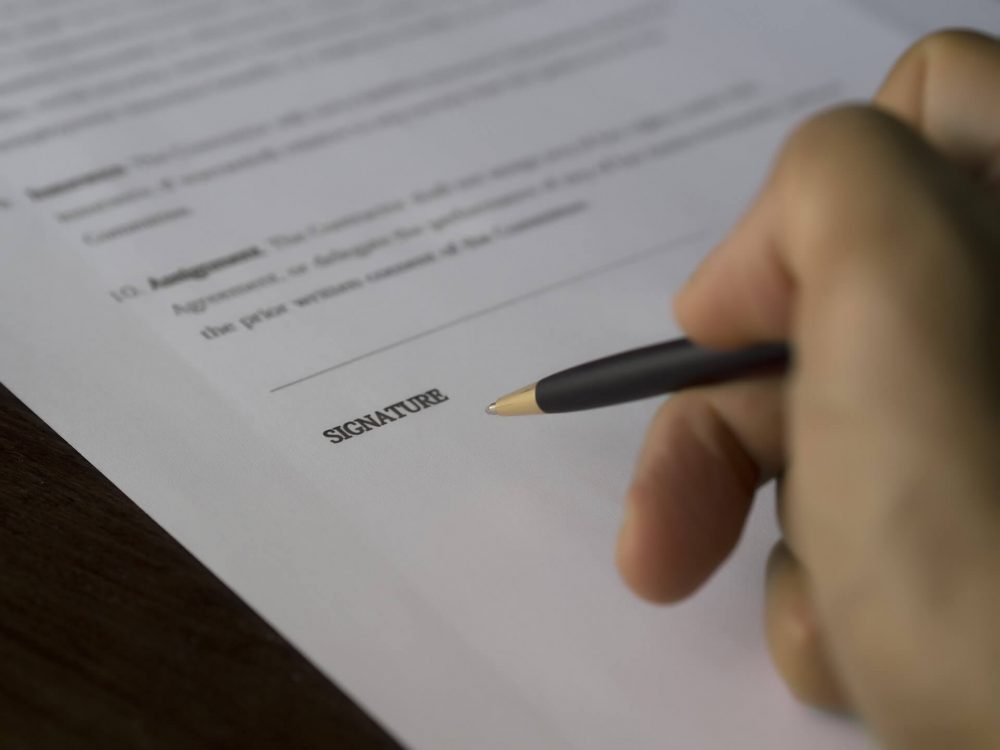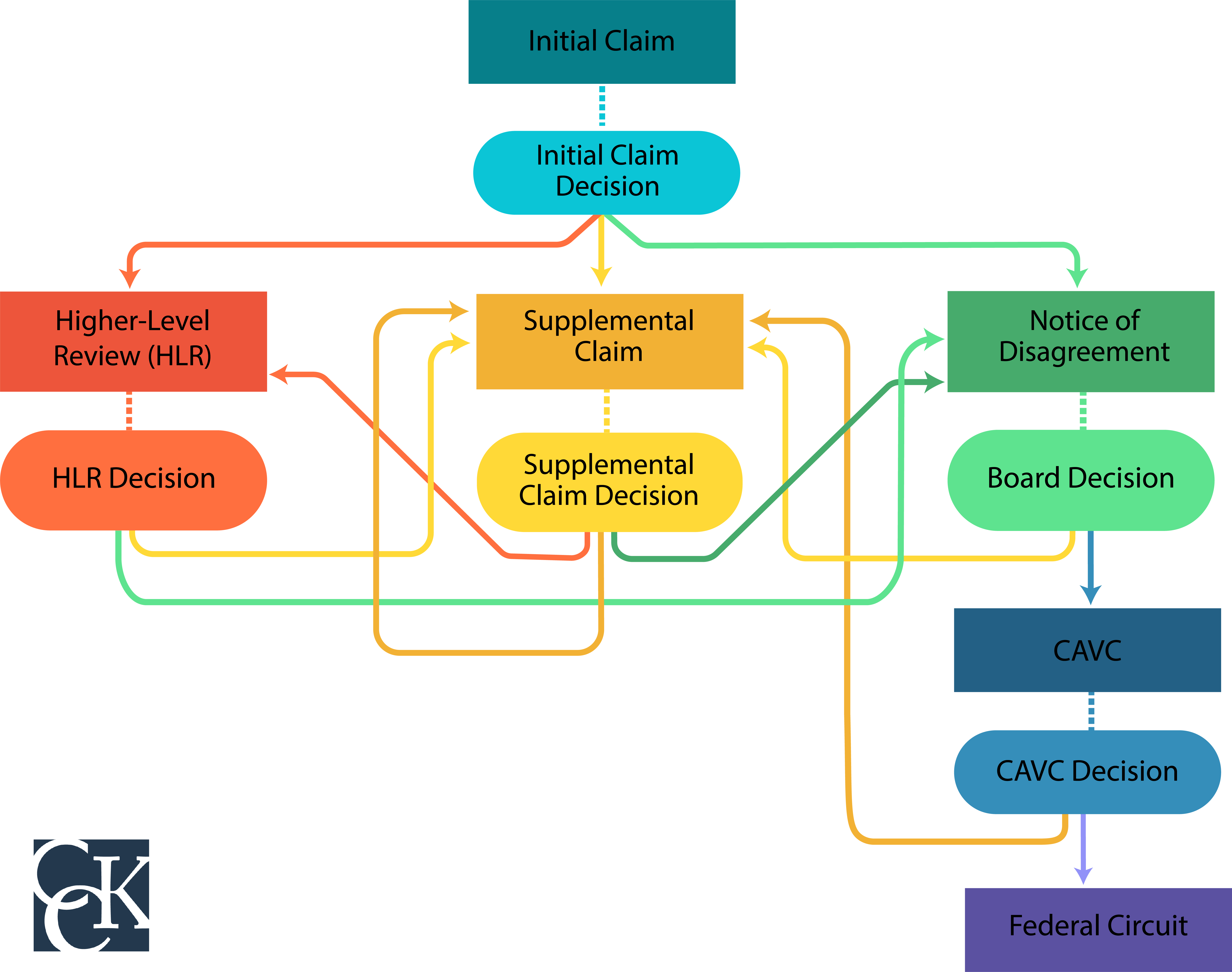How to File a VA Supplemental Claim

CCK Law: Our Vital Role in Veterans Law
What is a VA Supplemental Claim?
Upon full implementation of the Appeals Modernization Act (AMA), VA amended the definition of “claim” to include two types of VA claims: initial and supplemental.
A VA supplemental claim is a claim for disability benefits filed by a claimant who had previously filed for the same or similar benefits on the same or similar basis. The U.S. Department of Veterans Affairs (VA) is required to readjudicate the claim if new and relevant evidence is presented.
Overview of the Appeals Modernization Act (AMA)
The Appeals Modernization Act (AMA) was signed into law in 2017 and went into effect in early 2019. It gave veterans the freedom to choose one of three appeal lanes following an initial decision on a claim:
- Higher-Level Review Lane: A senior VA employee reviews the veteran’s current claim and issues a new decision. In this lane, the record is closed, meaning the veteran cannot submit any additional evidence.
- Supplemental Claim Lane: The veteran can submit new and relevant evidence in support of their claim.
- Notice of Disagreement Lane (i.e., Appeal to the Board of Veterans’ Appeals): The veteran can appeal their case directly to the Board of Veterans’ Appeals (Board).
After appealing through one of these three lanes, VA will make another decision on the veteran’s claim for benefits. Both the Higher-Level Review and Supplemental Claim lanes will yield Rating Decisions while the Notice of Disagreement lane will produce a Board decision.
At the Board there are three lanes from which veterans can choose: (1) the direct docket; (2) the hearing docket; and (3) the evidence docket.
In the direct docket, the Board considers only the evidence that was on record at the time of the agency of original jurisdiction’s (i.e., the Regional Office) decision. The hearing docket closes the record 90 days after the Board hearing. In the evidence docket, the record is closed 90 days after the veteran files the Notice of Disagreement.
VA Supplemental Claim Lane Explained
The Supplemental Claim lane under AMA is the only appeal lane in which VA has a duty to assist veterans in gathering evidence to support their claims. VA does not have a duty to assist during the Higher-Level Review process or in appeals to the Board.
Veterans must submit or inform VA of new and relevant evidence to open a supplemental claim. From there, veterans have up until the time VA issues a supplemental claim decision to submit any additional evidence.
What Is New and Relevant Evidence?
Again, this lane allows for the submission of new and relevant evidence. Here, “new” means that the evidence must not have been of record when VA was previously reviewing the claim. “Relevant” indicates that the evidence proves or disproves an issue related to the veteran’s claim.
Examples of new and relevant evidence include:
- Medical diagnoses
- Medical nexus opinions
- Service personnel records
- Service treatment records
- Lay evidence
The new and relevant evidence standard was implemented under AMA. This standard is supposed to reflect a lower evidentiary threshold than the “new and material” standard employed in the Legacy appeals system.
Issues with the New and Relevant Evidence Standard
A major problem with the new and relevant evidence standard, however, is that VA has been inconsistent when applying it to supplemental claims. There have been decisions where VA still refers to the old “new and material” evidence standard or where VA adjudicates claims in a way that suggests the new standard is higher (i.e., harder to meet) than the previous one.
When to File a VA Supplemental Claim
Veterans can file a supplemental claim following adjudicative action by submitting new and relevant evidence. Adjudicative action includes Rating Decisions, Board decisions, or Court of Appeals for Veterans Claims (CAVC) decisions.
The supplemental claim itself must be filed within one year of the date on VA’s decision letter to maintain the effective date of the original underlying claim. If the supplemental claim is filed more than one year after the decision, the effective date will be the date the supplemental claim was filed.
If a veteran submits an incomplete claim, VA will consider the claim to have been filed on the day VA receives the incomplete form, as long as a complete version is submitted within one year. By submitting the completed form within one year of the incomplete form, veterans can preserve their effective date.
A veteran can also submit a supplemental claim with new and relevant evidence if they were denied benefits in a Higher-Level Review. In other words, veterans are permitted to switch to the Supplemental Claim lane even after initially selecting the Higher-Level Review option. If this switch occurs within the one-year period following the date VA issued the decision on appeal, the veteran’s effective date will be preserved.
There is no limit on the number of supplemental claims a veteran can submit.
How to File a Supplemental VA Claim
In recent years, VA insists that veterans and claimants fill out the correct forms before it will address the filed claim. Under AMA, VA created new forms for the different review options.
Veterans are required to submit VA Form 20-0995, Decision Review Request: Supplemental Claim when initiating a supplemental claim for disability compensation. VA uses this form to identify the issues that a veteran is dissatisfied with and determine the veteran’s eligibility to apply for a supplemental claim.
How to Fill Out VA Supplemental Claim Form 20-0995
The supplemental claim form is broken up into the following sections:
- Claimant’s Identifying Information: This section requires claimants to fill out their full name, Social Security number, date of birth, current mailing address, telephone number, and benefit type (e.g., compensation, pension/survivors’ benefits, etc.).
- Information to Identify the Issues for Supplemental Claim: In this section, claimants must list each issue decided by VA that they would like VA to review as part of the supplemental claim. Each specific issue must be included along with the date of the VA decision notice in which disability benefits were originally denied or partially granted.
- New and Relevant Evidence: Here, claimants must submit or tell VA about new and relevant evidence they need assistance in gathering. If claimants want VA to obtain federal records, such as treatment records from VA medical centers, claimants must list the name and location of the facility and the dates of the records.
- Certification and Signature: This section is mandatory and completion is required for VA to process the supplemental claim. By signing, veterans are indicating that the information in the supplemental claim is true and correct.
Veterans should be sure to adhere to the instructions listed on the form to ensure their claim is accepted and processed by VA. Failing to do so may result in unnecessary delays.
Veterans who started their claim in the Legacy system must also check a box indicating that they will be opting in to the modernized review system. By checking that box, claimants are electing to participate in the AMA system and withdrawing all eligible appeal issues listed on the form from the Legacy system.

How Long Does a VA Supplemental Claim Take?
About 75 percent of veterans have been filing supplemental claims under AMA. Most veterans are choosing this lane after being issued an unfavorable decision due to missing evidence.
For example, a veteran gets a decision indicating that they are missing a diagnosis. As a result, the veteran goes to their doctor and obtains a diagnosis. This evidence would be considered new and relevant, and therefore, the Supplemental Claim lane would be the best choice to appeal VA’s decision.
Fortunately, VA has been processing supplemental claims at a moderate rate – VA’s claim timeline is generally around 60 days. Overall, VA has a 125-day goal for issuing decisions in this lane.
Veterans may also be able to track their VA claim status online by creating a VA account.
How CCK Can Help with Your Claim
If VA denied your disability claim due to missing evidence, Chisholm Chisholm & Kilpatrick LTD may be able to help you find the documentation you need to appeal the decision. The experienced and accredited veterans’ advocates at CCK know how to develop successful claims.
If you would like assistance with your supplemental claim, reach out to CCK today for a free consultation.
About the Author
Share this Post

